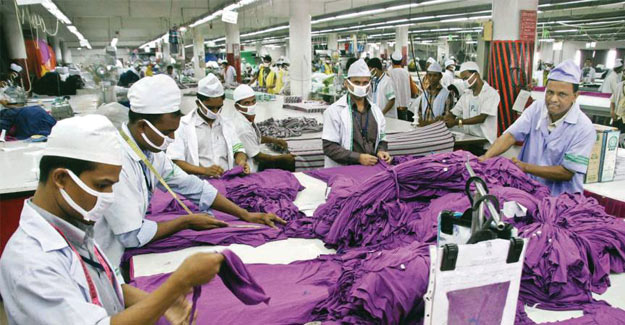
Bangladesh RMG Exporters Regret Going Green
According to industry experts, per capita carbon emission in Bangladesh is 0.46 tonnes a year whereas in the US, the EU and Canada the figure ranges between 10 tonnes to 25 tonnes. So, Bangladesh's factories do not even need to get green certification from other countries or companies, they opine.
The Metropolitan Chamber of Commerce and Industry (MCCI), in collaboration with the Adam Smith International and the UKAID, Bangladesh organised a dialogue on green compliance, which was attended by retailers, exporters, executives of different garment factories and researchers.
Currently, Bangladesh has the highest number of green garment factories along with top ranking units in the globe, said Shwapna Bhowmick, country head of Marks & Spencer. Bangladesh has outperformed its competitor countries in green compliance for garment factories and the nation should highlight its success stories to the world, she said.
In Bangladesh, 67 green garment factories have already obtained the LEED (Leadership in Energy and Environmental Design) certification from the US Green Building Council (USGBC) and over 300 more are waiting to be certified. "Bangladesh should market its achievements with effective communication skills," Bhowmick said. Marks & Spencer sources 40% of its garment items from Bangladesh, she said.
"The country produces a lot of value-added garment items although it was previously known as the producer of basic garment items only. However, we have broken this barrier as the producer of the highest selling value-added garment items."
For instance, Bhowmick said her company sources 90% of denim items from Bangladesh while local mills supply 70% of the fabrics needed to produce these denim items. However, Bangladesh needs to shorten its lead-time and improve the skills of the workers for higher productivity, she said.
The garment sector's strong green initiative was also noticed in the survey of the Partnership for a Cleaner Textile (PaCT) of the International Finance Corporation.
Local suppliers are doing great work in saving water, energy and environment, said Nishat Shahid Chowdhury, programme manager of Bangladesh PaCT. In Bangladesh, 250 textile factories have invested a total of US$ 39 million to save 21 billion litres of water a year thanks to the use of modern technologies, said Chowdhury.
Time has come to adopt the green compliance voluntarily, said Fahmida Khatun, executive director of the Centre for Policy Dialogue, a think-tank. Currently, 1,700 factories are running effluent treatment plants (ETPs) in their factories to save the environment.
The government should formulate policies to encourage private sector entrepreneurs to invest in green garment factories, said Shahpar Selim, a consultant of the Economic Dialogue on Green Growth, UKAID, while presenting the keynote paper on "Environmental compliance opportunities in Bangladesh's readymade garments industry: lessons from the green high achievers". Currently, two kinds of funds are available for setting up green factories but it is difficult to avail the fund, she said. Of the funds, the green refinancing fund of the central bank is relatively easier to avail, she said. Still, factory owners struggle to apply for this fund and the central bank should make the process easy, she said. Golam Mainuddin, MCCI vice-president; Miran Ali, managing director of Bitopi Group, and Suvojit Chattopadhyay, country manager of the Adam Smith International, also spoke.
Every reputed international retailer sources apparel from Bangladesh. The Accord and Alliance - representatives of the US and European retailers, have worked closely with Bangladesh apparel industry to improve compliances, workplace safety, labour rights. The government too has supported this endeavour, to save the country's economy, which relies heavily on garment exports. So, communicating the achievements of the industry will really not solve the problem that garment exporters are facing - low and stagnant unit value realisations.
Green garment factory owners want better prices
Green garment factory owners, who have spent billions of dollars for setting up the units, are left frustrated as international retailers are not rewarding them with higher prices for the initiative.
The factories cost 20-30% more to construct than the regular ones for their special design units. "The buyers do not pay even a single cent more for sourcing from a green garment factory," said KM Rezaul Hasanat, chairman and chief executive officer of Viyellatex Group, a leading garment exporter.
Had Viyellatex Group not constructed its two green garment factories in Gazipur, it could have employed 30% more workers, Hasanat said. "I regret making the green factories," he said, adding that the buyers pay much lower prices to Bangladeshi garment makers than the Chinese ones.
Kutubuddin Ahmed, chairman of Envoy Group, which has constructed the world's first platinum-rated green denim factory, echoed the same sentiment. "The buyers do not pay higher prices to us, but the branding gives us a mileage in selling the goods - they give priority to green factories," said Ahmed, whose main intent for setting up green factories was to lower the consumption of water and power.
According to Md Fazlul Hoque, managing director of Narayanganj-based Plummy Fashions, the platinum-rated knitwear factory,
"Although the buyers do not pay additional money for the virtue of sourcing from a green factory, there is room for bargaining for a little more price per unit due to the green factories. For instance, if the price of a T-shirt from a normal-compliant factory is $3, it is possible for green factories to get 10 cents more. The buyers though do not pay high prices to green factories out of their own volition." According to BGMEA, the prices of Bangladeshi-made garment items have declined 40% over the last 15 years.
Textile Excellence
If you wish to Subscribe to Textile Excellence Print Edition, kindly fill in the below form and we shall get back to you with details.








